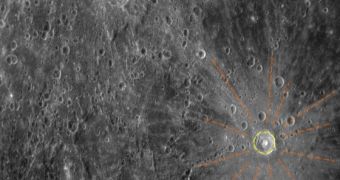Yesterday, the MESSENGER spacecraft performed its second Mercury pass-by, and began transmitting data back to Earth. The images showed that our solar system's first member is packed with relatively young, bright craters and a wide rays pattern, associating the planet' s weather phenomenons with similar ones that our moon went through.
NASA's MESSENGER spacecraft (MErcury Surface, Space ENvironment, GEochemistry, and Ranging) performed its first such flyby in January this year. During that mission, it provided images of 20% of the surface of Mercury that hadn't been observed before, which indicated the planet's violent volcanic history and the continuous exposure to meteoritic bombardments. This second time, it will continue to send large previews of 30% of the planet's northern hemisphere until Wednesday, which are also first sights. These two are the first in a series of missions that aims to place the spacecraft on planetary orbit in March 2011.
According to MESSENGER principal investigator Sean Solomon from the Carnegie Institution of Washington, Mercury seems to host “extremely deformed regions,” as well as “extraordinarily bright red craters, with rays that extend halfway across the planet.” Studies on our moon help scientists develop theories on the planet's evolution, as they associate the red color of its craters with their young age, which didn't allow for a long exposure to weather effects.
But there are also considerable differences between the two space bodies, like the presence of iron in the moon, which have to be further studied and their consequences fully comprehended. Iron allows the moon's craters to get darker in time, after being exposed to the harsh weather for a long time, but since it is absent on Mercury, there must be some other material that provides it with the same withering feature.
Although seen before by means of Earth radars, this is the first time that experts get a space image of the extensively rayed craters to the north and south of the Kuiper crater discovered by the Mariner 10 spacecraft in 1974 and 1975. The rays are formed by the material that is eliminated by the planet upon impacts with meteorites, which can last for hundreds of millions of years in the case of the moon.
Researchers hope that the approximately 1,200 images that the craft situated 61 million miles (99 million kilometers) away will send back are going to help them uncover more of the mysteries that surround Mercury's geology. The next flyby is scheduled to take place a year from now, in September 2009.

 14 DAY TRIAL //
14 DAY TRIAL //